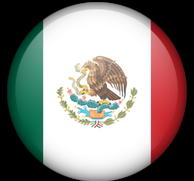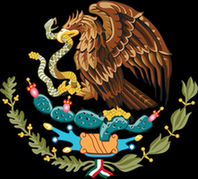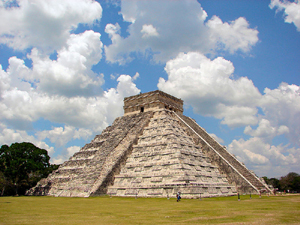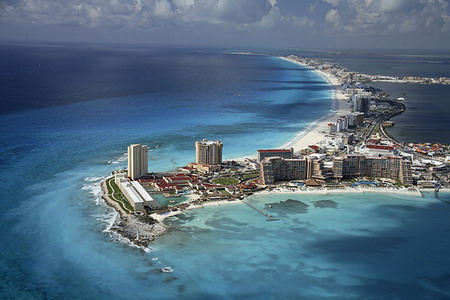The United Mexican States, Los Estados Unidos Mexicanos, commonly known as Mexico, is a federal constitutional republic in North America. Covering almost 2 million square kilometres, Mexico is the fifth-largest country in the Americas by total area and the 14th largest independent nation in the world. With an estimated population of 109 million, it is the 11th most populous country. Mexico is a federation comprising thirty-one states and a Federal District, the capital city.
|

Mexican national flag
|
 coat of arms of Mexico
coat of arms of Mexico |
Facts and Statistics
Location: Middle America, bordering the Caribbean Sea and the Gulf of Mexico, between Belize and the US and bordering the North Pacific Ocean, between Guatemala and the US
Capital: Mexico City
Climate: varies from tropical to desert
Population: 106 million (2006 est.)
Ethnic Make-up: mestizo (Amerindian-Spanish) 60%, Amerindian or predominantly Amerindian 30%, white 9%, other 1%
Religions: nominally Roman Catholic 89%, Protestant 6%, other 5%
Government: federal republic
History
For thousands of years, what is now known as Mexico was a land of hunter-gatherers. Around 9,000 years ago, ancient Amerindians domesticated corn and initiated an agricultural revolution, leading to the formation of many complex civilizations. These civilizations revolved around cities with writing, monumental architecture, astronomical studies, mathematics, and militaries. After 4,000 years, these civilizations were destroyed with the arrival of the Spaniards in 1519. For three centuries, Mexico was colonized by Spain, during which time the majority of its indigenous population died off. Formal independence from Spain was recognized in 1821. A war with the United States ended with Mexico losing almost half of its territory in 1848. France then invaded Mexico in 1861 and ruled briefly until 1867. The Mexican Revolution would later result in the death of 10% of the nation's population. Since then, Mexico as a nation-state has struggled with reconciling its deeply-entrenched indigenous heritage with the demands of the modern Western cultural model imposed in 1519. The nation's name is derived from the Aztec's capital called Mexico-Tenochtitlan.
Mexican Society & Culture
Mexican culture reflects the complexity of the country's history through the blending of pre-Hispanic civilizations and the culture of Spain, imparted during Spain's 300-year colonization of Mexico.
Mexico is the most populous Spanish-speaking country in the world. The overwhelming majority of Mexicans today speak Spanish, however, the government recognizes 62 indigenous Amerindian languages as national languages.
|

Archaeological sites of Chichén-Itzá, one of the New Seven Wonders. [file]
|
The Spanish arrival and colonization brought Roman Catholicism to the country and became the main religion of Mexico. Today, 95% of the population are baptized Catholics, making the country as the second largest Catholic nation in the world, after Brazil.
Mexico is known worldwide for its folk art traditions, mostly derived from the indigenous and Spanish crafts. Between the Spanish conquest and the early Twentieth century, Mexican fine arts were largely in imitation of European traditions. The city of Taxco, Guerrero, which is one of the oldest mining sites in the Americas, is world-renowned for its silver work.
With twenty-nine sites, Mexico has more sites on the UNESCO World Heritage list than any other country in the Americas, most of which pertain to the country's architectural history.
Mexican Family Values
The family is at the centre of the social structure. Outside of the major cosmopolitan cities, families are still generally large. The extended family is as important as the nuclear family since it provides a sense of stability. Mexicans consider it their duty and responsibility to help family members. For example, the will help find employment or finance a house or other large purchase. Most Mexican families are extremely traditional, with the father as the head, the authority figure and the decision-maker. Mothers are greatly revered, but their role may be seen as secondary to that of their husband.
Hierarchical Society
Mexican society and business are highly stratified and vertically structured. Mexicans emphasize hierarchical relationships. People respect authority and look to those above them for guidance and decision-making. Rank is important, and those above you in rank must always be treated with respect. This makes it important to know which person is in charge, and leads to an authoritarian approach to decision-making and problem- solving. Mexicans are very aware of how each individual fits into each hierarchy -- be it family, friends or business. It would be disrespectful to break the chain of hierarchy
Tourism
According to the World Tourism Organization, Mexico has one of the largest tourism industries in the world. In 2005 it was the seventh most popular tourist destination worldwide, receiving over 20 million tourists per year; it is the only country in Latin America to be within the top 25. Tourism is also the third largest sector in the country's industrial GDP.
|

The picture from Cancun's official travel website shows the city's beautiful scenery. [cancun.travel]
|
The most notable tourist draws are the ancient Meso-American ruins, and popular beach resorts. The coastal climate and unique culture – a fusion of European (particularly Spanish) and Meso-American cultures; also make Mexico attractive. The peak tourist seasons in Mexico are during December and during July and August, with brief surges during the week before Easter and during spring break at many of the beach resort sites which are popular among vacationing college students from the United States.
Mexico is the twenty-third highest tourism spender in the world, and the highest in Latin America.

